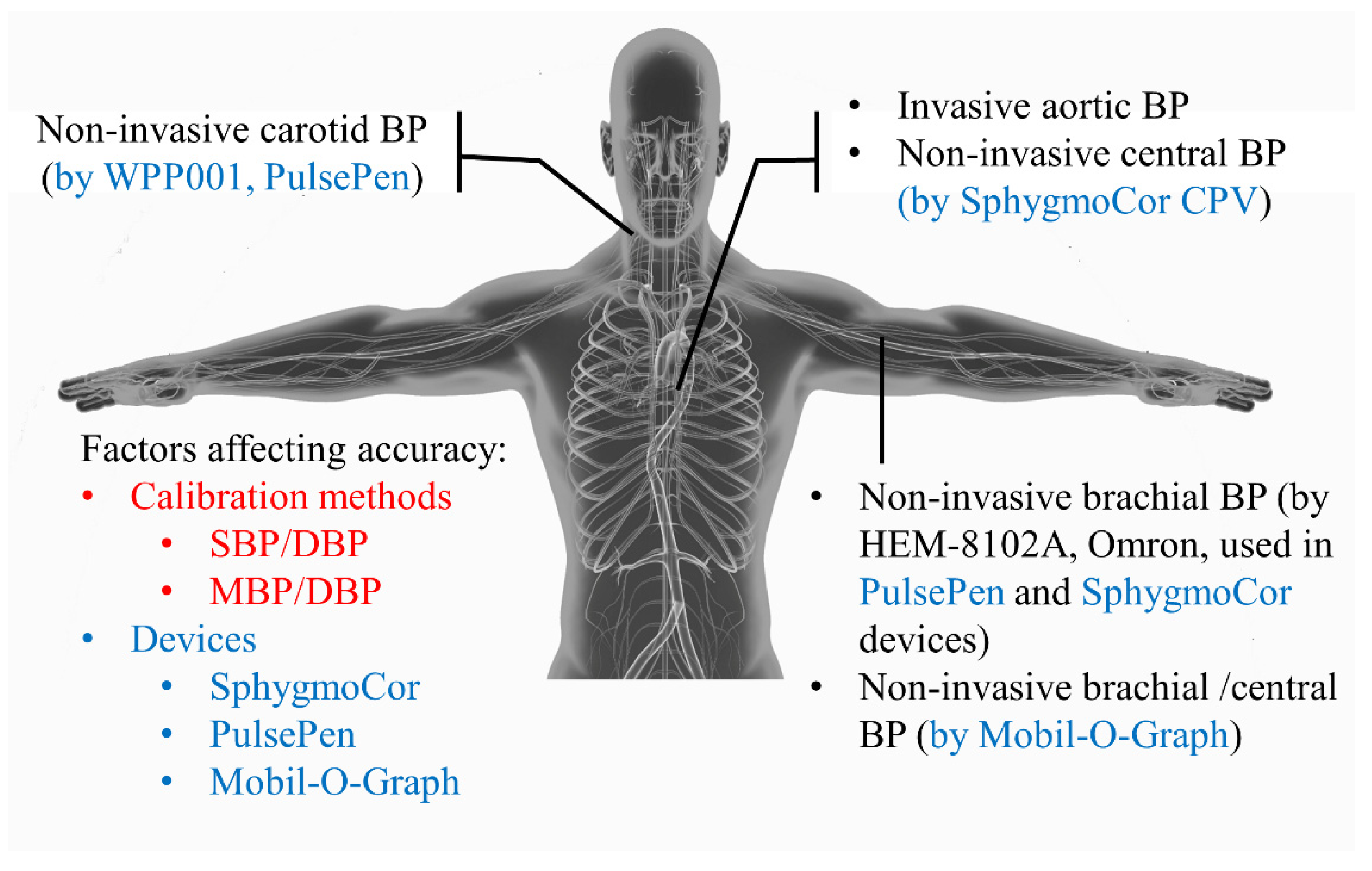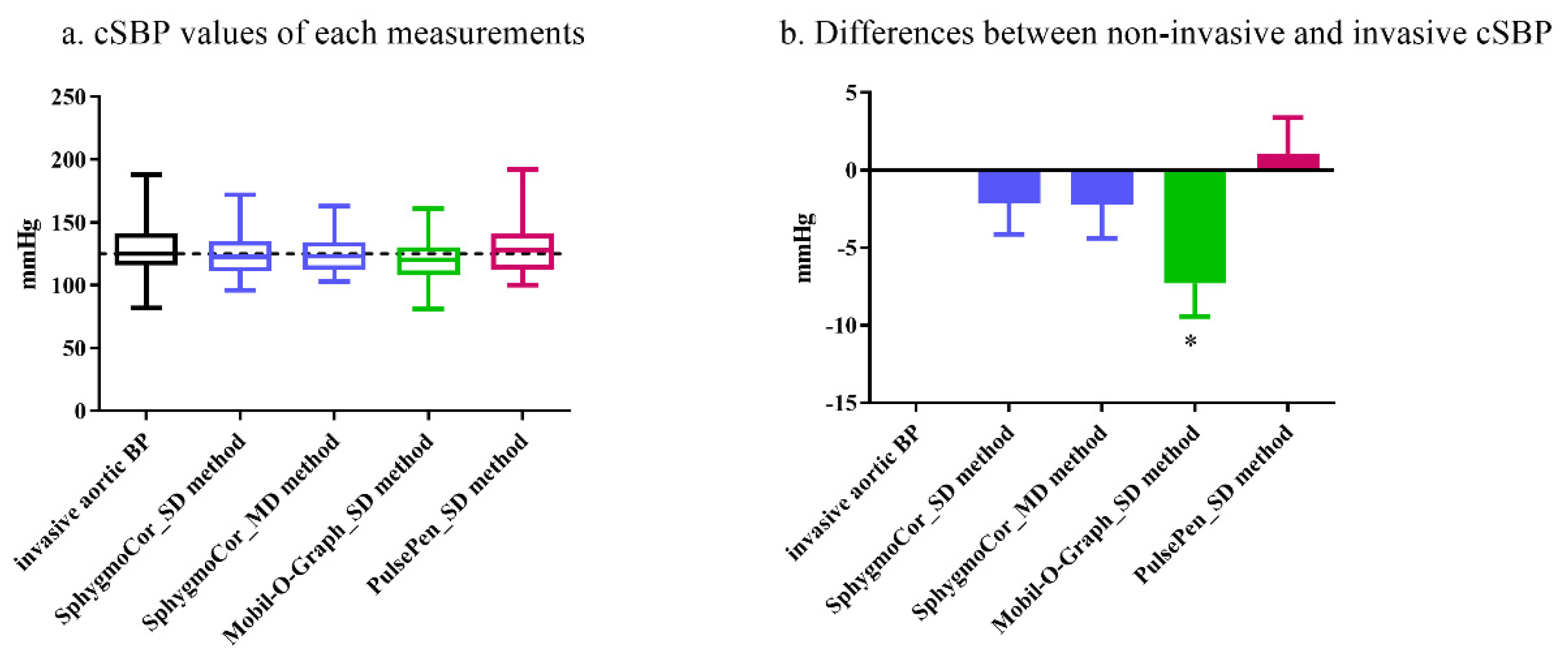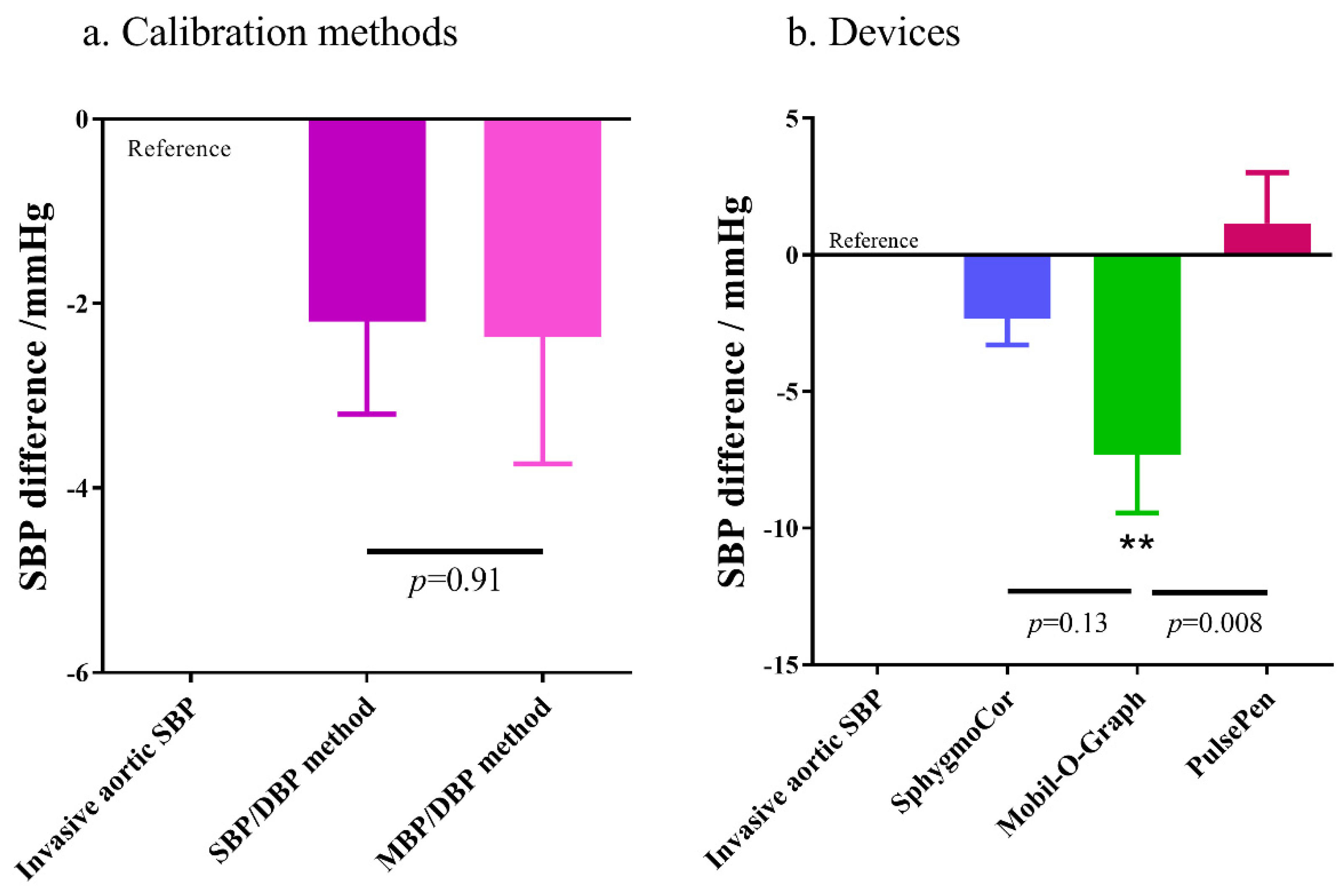Factors That May Impact the Noninvasive Measurement of Central Blood Pressure Compared to Invasive Measurement: The MATCHY Study
Abstract
1. Introduction
2. Materials and Methods
2.1. Study Design and Participants
2.2. Anthropometric Measurements, Clinical Characteristics, and Laboratory Examinations
2.3. Invasive Blood Pressure Measurement
2.4. Noninvasive Blood Pressure Measurement
2.5. Calibration Methods of Noninvasive Aortic Blood Pressure Measurement
2.6. Statistical Analysis
3. Results
3.1. Characteristics of Participants
3.2. Invasive and Noninvasive BP Measurement Parameters
3.3. Central SBP Values Using Different Calibration Methods and Comparison with Invasive Measurements
3.4. Correlations between Each Noninvasive and Invasive Central SBP Measurements
3.5. Pooled Analysis of the Three Potentially Influencing Factors
3.6. Multiple Regression Analyses
4. Discussion
5. Conclusions
Author Contributions
Funding
Institutional Review Board Statement
Informed Consent Statement
Data Availability Statement
Conflicts of Interest
References
- Williams, B.; Mancia, G.; Spiering, W.; Agabiti Rosei, E.; Azizi, M.; Burnier, M.; Clement, D.L.; Coca, A.; de Simone, G.; Dominiczak, A.; et al. 2018 ESC/ESH Guidelines for the management of arterial hypertension: The Task Force for the management of arterial hypertension of the European Society of Cardiology and the European Society of Hypertension. J. Hypertens. 2018, 36, 1953–2041. [Google Scholar] [CrossRef] [PubMed]
- Peluso, G.; Garcia-Espinosa, V.; Curcio, S.; Marota, M.; Castro, J.; Chiesa, P.; Giachetto, G.; Bia, D.; Zocalo, Y. High Central Aortic Rather than Brachial Blood Pressure is Associated with Carotid Wall Remodeling and Increased Arterial Stiffness in Childhood. High Blood Press. Cardiovasc. Prev. Off. J. Ital. Soc. Hypertens. 2017, 24, 49–60. [Google Scholar] [CrossRef] [PubMed]
- Chi, C.; Yu, X.; Auckle, R.; Lu, Y.; Fan, X.; Yu, S.; Xiong, J.; Bai, B.; Teliewubai, J.; Zhou, Y.; et al. Hypertensive target organ damage is better associated with central than brachial blood pressure: The Northern Shanghai Study. J. Clin. Hypertens. (Greenwich Conn.) 2017, 19, 1269–1275. [Google Scholar] [CrossRef]
- Booysen, H.L.; Norton, G.R.; Maseko, M.J.; Libhaber, C.D.; Majane, O.H.; Sareli, P.; Woodiwiss, A.J. Aortic, but not brachial blood pressure category enhances the ability to identify target organ changes in normotensives. J. Hypertens. 2013, 31, 1124–1130. [Google Scholar] [CrossRef] [PubMed]
- Hashimoto, J. Central Hemodynamics for Management of Arteriosclerotic Diseases. J. Atheroscler. Thromb. 2017, 24, 765–778. [Google Scholar] [CrossRef] [PubMed]
- Cheng, H.M.; Lang, D.; Tufanaru, C.; Pearson, A. Measurement accuracy of non-invasively obtained central blood pressure by applanation tonometry: A systematic review and meta-analysis. Int. J. Cardiol. 2013, 167, 1867–1876. [Google Scholar] [CrossRef]
- Sharman, J.E.; Avolio, A.P.; Baulmann, J.; Benetos, A.; Blacher, J.; Blizzard, C.L.; Boutouyrie, P.; Chen, C.H.; Chowienczyk, P.; Cockcroft, J.R.; et al. Validation of non-invasive central blood pressure devices: ARTERY Society task force consensus statement on protocol standardization. Eur. Heart J. 2017, 38, 2805–2812. [Google Scholar] [CrossRef]
- Narayan, O.; Casan, J.; Szarski, M.; Dart, A.M.; Meredith, I.T.; Cameron, J.D. Estimation of central aortic blood pressure: A systematic meta-analysis of available techniques. J. Hypertens. 2014, 32, 1727–1740. [Google Scholar] [CrossRef]
- Kelly, R.; Fitchett, D. Noninvasive determination of aortic input impedance and external left ventricular power output: A validation and repeatability study of a new technique. J. Am. Coll. Cardiol. 1992, 20, 952–963. [Google Scholar] [CrossRef]
- Pauca, A.L.; O’Rourke, M.F.; Kon, N.D. Prospective evaluation of a method for estimating ascending aortic pressure from the radial artery pressure waveform. Hypertension 2001, 38, 932–937. [Google Scholar] [CrossRef]
- Williams, B.; Lacy, P.S.; Yan, P.; Hwee, C.N.; Liang, C.; Ting, C.M. Development and validation of a novel method to derive central aortic systolic pressure from the radial pressure waveform using an n-point moving average method. J. Am. Coll. Cardiol. 2011, 57, 951–961. [Google Scholar] [CrossRef] [PubMed]
- Pauca, A.L.; Wallenhaupt, S.L.; Kon, N.D.; Tucker, W.Y. Does radial artery pressure accurately reflect aortic pressure? Chest 1992, 102, 1193–1198. [Google Scholar] [CrossRef] [PubMed]
- O’Rourke, M.F.; Adji, A. Clinical use of applanation tonometry: Hope remains in Pandora’s box. J. Hypertens. 2010, 28, 229–233. [Google Scholar] [CrossRef] [PubMed]
- Picone, D.S.; Schultz, M.G.; Peng, X.; Black, J.A.; Dwyer, N.; Thomson, P.R.; Qasem, A.; Sharman, J.E. Intra-arterial analysis of the best calibration methods to estimate aortic blood pressure. J. Hypertens. 2019, 37, 307–315. [Google Scholar] [CrossRef] [PubMed]
- Schultz, M.G.; Picone, D.S.; Armstrong, M.K.; Black, J.A.; Dwyer, N.; Thomson, P.R.; Sturgess, D.; Sharman, J.E. The influence of SBP amplification on the accuracy of form-factor-derived mean arterial pressure. J. Hypertens. 2020, 38, 1033–1039. [Google Scholar] [CrossRef]
- O’Rourke, M.F.; Adji, A. Noninvasive studies of central aortic pressure. Curr. Hypertens. Rep. 2012, 14, 8–20. [Google Scholar] [CrossRef]
- Mitchell, G.F.; Hwang, S.J.; Vasan, R.S.; Larson, M.G.; Pencina, M.J.; Hamburg, N.M.; Vita, J.A.; Levy, D.; Benjamin, E.J. Arterial stiffness and cardiovascular events: The Framingham Heart Study. Circulation 2010, 121, 505–511. [Google Scholar] [CrossRef]
- Weber, T.; Wassertheurer, S.; Rammer, M.; Maurer, E.; Hametner, B.; Mayer, C.C.; Kropf, J.; Eber, B. Validation of a brachial cuff-based method for estimating central systolic blood pressure. Hypertension 2011, 58, 825–832. [Google Scholar] [CrossRef]
- Cameron, J.D.; McGrath, B.P.; Dart, A.M. Use of radial artery applanation tonometry and a generalized transfer function to determine aortic pressure augmentation in subjects with treated hypertension. J. Am. Coll. Cardiol. 1998, 32, 1214–1220. [Google Scholar] [CrossRef]
- O’Rourke, M.F.; Safar, M.E.; Roman, M.J. Letter by O’Rourke et al regarding article, “Arterial stiffness and cardiovascular events: The Framingham Heart Study”. Circulation 2010, 122, e512, author reply e515. [Google Scholar] [CrossRef][Green Version]
- Kroeker, E.J.; Wood, E.H. Comparison of simultaneously recorded central and peripheral arterial pressure pulses during rest, exercise and tilted position in man. Circ. Res. 1955, 3, 623–632. [Google Scholar] [CrossRef] [PubMed]
- Rowell, L.B.; Brengelmann, G.L.; Blackmon, J.R.; Bruce, R.A.; Murray, J.A. Disparities between aortic and peripheral pulse pressures induced by upright exercise and vasomotor changes in man. Circulation 1968, 37, 954–964. [Google Scholar] [CrossRef] [PubMed]
- Kelly, R.P.; Gibbs, H.H.; O’Rourke, M.F.; Daley, J.E.; Mang, K.; Morgan, J.J.; Avolio, A.P. Nitroglycerin has more favourable effects on left ventricular afterload than apparent from measurement of pressure in a peripheral artery. Eur. Heart J. 1990, 11, 138–144. [Google Scholar] [CrossRef] [PubMed]
- Segers, P.; Mahieu, D.; Kips, J.; Rietzschel, E.; De Buyzere, M.; De Bacquer, D.; Bekaert, S.; De Backer, G.; Gillebert, T.; Verdonck, P.; et al. Amplification of the pressure pulse in the upper limb in healthy, middle-aged men and women. Hypertension 2009, 54, 414–420. [Google Scholar] [CrossRef] [PubMed]
- Davies, J.E.; Shanmuganathan, M.; Francis, D.P.; Mayet, J.; Hackett, D.R.; Hughes, A.D. Caution using brachial systolic pressure to calibrate radial tonometric pressure waveforms: Lessons from invasive study. Hypertension 2010, 55, e4. [Google Scholar] [CrossRef][Green Version]




| General Characteristics | |
|---|---|
| Age (years) | 62.4 ± 8.9 |
| Male (n, %) | 23 (46) |
| BMI (kg/m2) | 25.1 ± 3.0 |
| Current smoker (n, %) | 11 (22) |
| Alcohol (n, %) | 7 (14) |
| Hypertension (n, %) | 31 (62) |
| Anti-hypertensive treatment (n, %) | 28 (56) |
| ACE inhibitor/ARB | 15 (30) |
| Beta-receptor blocker | 5 (10) |
| Calcium channel blocker | 15 (30) |
| Diuretics | 5 (10) |
| Other agents | 1 (2) |
| Diabetes (n, %) | 4 (8) |
| Oral hypoglycemic agents | 3 (6) |
| Insulin | 1 (2) |
| eGFR (mL/min/1.73 m2) | 117 ± 29 |
| Aortic BP | Carotid BP | Peripheral BP * | ||||
|---|---|---|---|---|---|---|
| SBP | DBP | SBP | DBP | SBP | DBP | |
| Invasive | 127 ± 19 | 95 ± 14 | 124 ± 20 | 91 ± 14 | 139 ± 26 | 76 ± 12 |
| SphygmoCor | 125 ± 18 | 77 ± 10 | 126 ± 21 | 77 ± 10 | -- | -- |
| PulsePen | -- | -- | 128 ± 20 | 76 ± 10 | -- | -- |
| Mobil-O-Graph | 120 ± 16 | 85 ± 11 | -- | -- | 126 ± 19 | 85 ± 11 |
| Omron | -- | -- | -- | -- | 140 ± 19 | 77 ± 10 |
| SphygmoCor | Mobil-O-Graph | PulsePen | |||
|---|---|---|---|---|---|
| Correlations | SBP/DBP | MBP/DBP | SBP/DBP | SBP/DBP | |
| Invasive aortic SBP | R p | 0.72 <0.001 | 0.63 <0.001 | 0.66 <0.001 | 0.70 <0.001 |
| Comparison of Correlation Coefficients (Z-Value, p-Value) | |||||
| SphygmoCor | SBP/DBP | -- | |||
| MBP/DBP | 2.49, 0.01 | -- | |||
| Mobil-O-Graph | SBP/DBP | 0.81, 0.42 | −0.40, 0.69 | -- | |
| PulsePen | SBP/DBP | 0.31, 0.76 | −1.00, 0.32 | −0.47, 0.64 | -- |
| Multiple Linear Regression (Independent Variable: Difference between Invasive and Noninvasive Measurements) | |||
|---|---|---|---|
| β | SE | p | |
| age (+ 1 year) | −0.07 | 0.06 | 0.27 |
| gender (male = 1, female = 0) | −4.22 | 1.11 | <0.001 |
| calibration method (SBP/DBP = 1, MBP/DBP = 0) | −0.48 | 1.33 | 0.72 |
| device (SphygmoCor = 1, others = 0) | −2.17 | 1.26 | 0.09 |
| Multiple logistic regression (independent variable: accuracy (difference < 5 mmHg) of noninvasive measurement) | |||
| OR | 95% CI | p | |
| age (+ 1 year) | 1.00 | 0.97, 1.03 | 0.99 |
| gender (male = 1, female = 0) | 0.41 | 0.25, 0.69 | <0.001 |
| calibration method (SBP/DBP = 1, MBP/DBP = 0) | 0.63 | 0.33, 1.23 | 0.18 |
| device (SphygmoCor = 1, others = 0) | 1.14 | 0.65, 2.02 | 0.64 |
Publisher’s Note: MDPI stays neutral with regard to jurisdictional claims in published maps and institutional affiliations. |
© 2022 by the authors. Licensee MDPI, Basel, Switzerland. This article is an open access article distributed under the terms and conditions of the Creative Commons Attribution (CC BY) license (https://creativecommons.org/licenses/by/4.0/).
Share and Cite
Chi, C.; Lu, Y.; Zhou, Y.; Li, J.; Xu, Y.; Zhang, Y. Factors That May Impact the Noninvasive Measurement of Central Blood Pressure Compared to Invasive Measurement: The MATCHY Study. J. Pers. Med. 2022, 12, 1482. https://doi.org/10.3390/jpm12091482
Chi C, Lu Y, Zhou Y, Li J, Xu Y, Zhang Y. Factors That May Impact the Noninvasive Measurement of Central Blood Pressure Compared to Invasive Measurement: The MATCHY Study. Journal of Personalized Medicine. 2022; 12(9):1482. https://doi.org/10.3390/jpm12091482
Chicago/Turabian StyleChi, Chen, Yi Lu, Yiwu Zhou, Jiaxin Li, Yawei Xu, and Yi Zhang. 2022. "Factors That May Impact the Noninvasive Measurement of Central Blood Pressure Compared to Invasive Measurement: The MATCHY Study" Journal of Personalized Medicine 12, no. 9: 1482. https://doi.org/10.3390/jpm12091482
APA StyleChi, C., Lu, Y., Zhou, Y., Li, J., Xu, Y., & Zhang, Y. (2022). Factors That May Impact the Noninvasive Measurement of Central Blood Pressure Compared to Invasive Measurement: The MATCHY Study. Journal of Personalized Medicine, 12(9), 1482. https://doi.org/10.3390/jpm12091482







